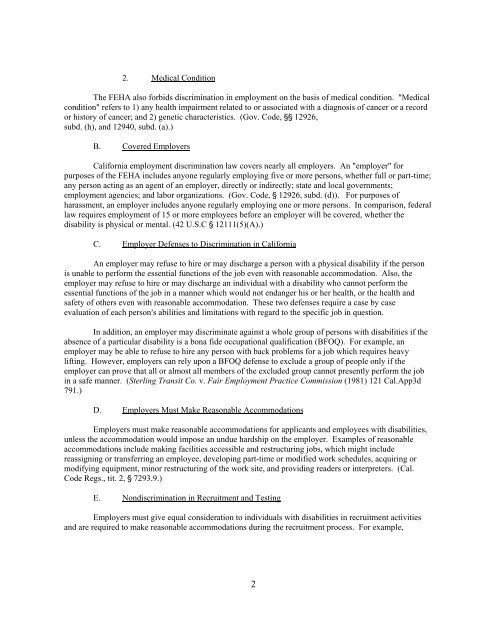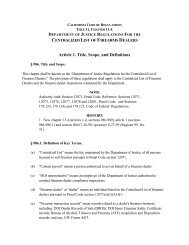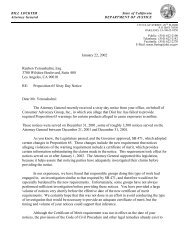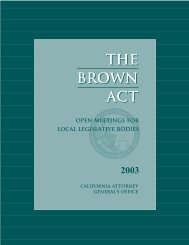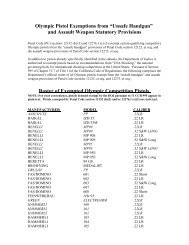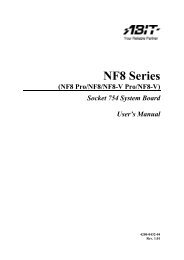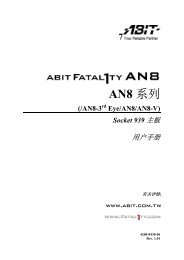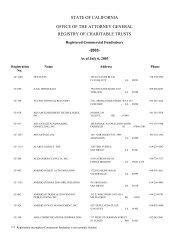Legal Rights of Persons With Disabilities - Ossh.com
Legal Rights of Persons With Disabilities - Ossh.com
Legal Rights of Persons With Disabilities - Ossh.com
Create successful ePaper yourself
Turn your PDF publications into a flip-book with our unique Google optimized e-Paper software.
2. Medical Condition<br />
The FEHA also forbids discrimination in employment on the basis <strong>of</strong> medical condition. "Medical<br />
condition" refers to 1) any health impairment related to or associated with a diagnosis <strong>of</strong> cancer or a record<br />
or history <strong>of</strong> cancer; and 2) genetic characteristics. (Gov. Code, '' 12926,<br />
subd. (h), and 12940, subd. (a).)<br />
B. Covered Employers<br />
California employment discrimination law covers nearly all employers. An "employer" for<br />
purposes <strong>of</strong> the FEHA includes anyone regularly employing five or more persons, whether full or part-time;<br />
any person acting as an agent <strong>of</strong> an employer, directly or indirectly; state and local governments;<br />
employment agencies; and labor organizations. (Gov. Code, ' 12926, subd. (d)). For purposes <strong>of</strong><br />
harassment, an employer includes anyone regularly employing one or more persons. In <strong>com</strong>parison, federal<br />
law requires employment <strong>of</strong> 15 or more employees before an employer will be covered, whether the<br />
disability is physical or mental. (42 U.S.C ' 12111(5)(A).)<br />
C. Employer Defenses to Discrimination in California<br />
An employer may refuse to hire or may discharge a person with a physical disability if the person<br />
is unable to perform the essential functions <strong>of</strong> the job even with reasonable ac<strong>com</strong>modation. Also, the<br />
employer may refuse to hire or may discharge an individual with a disability who cannot perform the<br />
essential functions <strong>of</strong> the job in a manner which would not endanger his or her health, or the health and<br />
safety <strong>of</strong> others even with reasonable ac<strong>com</strong>modation. These two defenses require a case by case<br />
evaluation <strong>of</strong> each person=s abilities and limitations with regard to the specific job in question.<br />
In addition, an employer may discriminate against a whole group <strong>of</strong> persons with disabilities if the<br />
absence <strong>of</strong> a particular disability is a bona fide occupational qualification (BFOQ). For example, an<br />
employer may be able to refuse to hire any person with back problems for a job which requires heavy<br />
lifting. However, employers can rely upon a BFOQ defense to exclude a group <strong>of</strong> people only if the<br />
employer can prove that all or almost all members <strong>of</strong> the excluded group cannot presently perform the job<br />
in a safe manner. (Sterling Transit Co. v. Fair Employment Practice Commission (1981) 121 Cal.App3d<br />
791.)<br />
D. Employers Must Make Reasonable Ac<strong>com</strong>modations<br />
Employers must make reasonable ac<strong>com</strong>modations for applicants and employees with disabilities,<br />
unless the ac<strong>com</strong>modation would impose an undue hardship on the employer. Examples <strong>of</strong> reasonable<br />
ac<strong>com</strong>modations include making facilities accessible and restructuring jobs, which might include<br />
reassigning or transferring an employee, developing part-time or modified work schedules, acquiring or<br />
modifying equipment, minor restructuring <strong>of</strong> the work site, and providing readers or interpreters. (Cal.<br />
Code Regs., tit. 2, ' 7293.9.)<br />
E. Nondiscrimination in Recruitment and Testing<br />
Employers must give equal consideration to individuals with disabilities in recruitment activities<br />
and are required to make reasonable ac<strong>com</strong>modations during the recruitment process. For example,<br />
2


